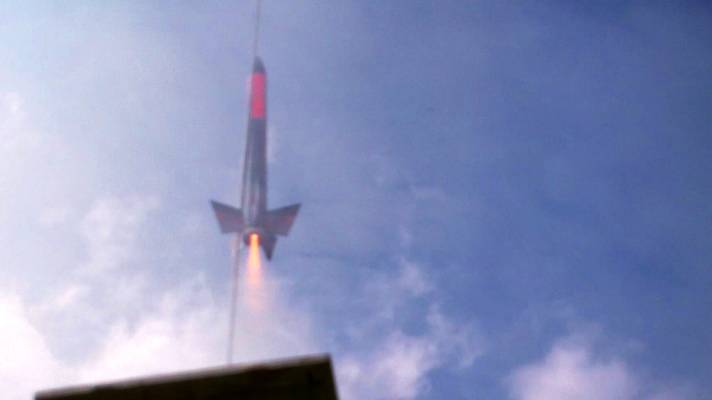The Black Diamond: This model is extremely fast and light, uses 1/2A to C motors, although I'm a bit afraid to try a C in this little gem. I imagine it could easily reach 1200 feet. It features streamer recovery. Added a lot of nose weight to balance this model, but now it flies very straight and true even in windy conditions. I was a bit concerned about cardboard fins, but they are very stiff and seem to work well (I just hope they don't get bent!) This rocket was later given my "Iris" modification, which extends the body tube about 5 inches above the streamer/parachute bay, and allows for a payload with an Altimeter One to measure altitudes. With the added weight, I needed a longer, 4-foot long, 2-inch wide streamer to slow it down some. Not so easy to squeeze into a BT-20 body. I had to lengthen the shock cord also, but it is still getting quite beat-up by its own recoil force. (Iris is named after the Greek god of the rainbow. She is a messenger of the gods, linking the gods with humanity.) If I were to build another one, I would split the launch lug and glue half of it further toward the nose. As it is, it wobbles on liftoff some while on the rod. I have only once tried this on a C motor, this rocket has flown higher than the Aon Center and the John Hancock Tower in Chicago, and the NY Times Building in NY, NY.
| Flight Date: | 2012-04-01 |
| Rocket Name: | Black Diamond |
| Kit Name: | Estes - Black Diamond {Kit} |
| Flyer's Name: | Rich DeAngelis |
| Motors: | B6-4 |
| Launch Site: | Penn Manor School Lancaster PA |
| Actual Altitude: | 479 Feet |
This high-performance rocket can handle gusty winds because it launches very fast and it's added length and noseweight helps keep it stable with it's small, thin fins. Also, having bad luck with parachutes today I was releived to be flying a bird with streamer recovery.
The B motor burned for 8/10 second, accelerating to a peak of 18.6 Gs. The rocket shot up straight as a laser. The average acceleration of 6.7 Gs is better than I get with an A8 or C6 motor. With this power, it reached a top speed of 121 mph and an apogee of 479 feet, not quite as good as a previous B6 flight.
As in the previous flight, the ejection fired almost a second too early at 3.1 seconds while at 434 feet and while still coasting straight up for another 45 feet. The empty casing was ejected which I assume added to the vertical velocity. 8/10 seconds later it stopped at apogee before falling.
The streamer unwound slowly and the rocket descended at it's expected 18 mph to keep it from getting lost. It landed after a 20 second flight time. A good flight, although it didn't set any altitude or speed records. (which is 529', 123 mph on B6 motors). A B6-6 would have flown higher, even in the moderate and gusty winds on this day.
| Stage | Motor(s) |
|---|---|
| 1 | Estes B6-4 |
Sponsored Ads
 |
 |












